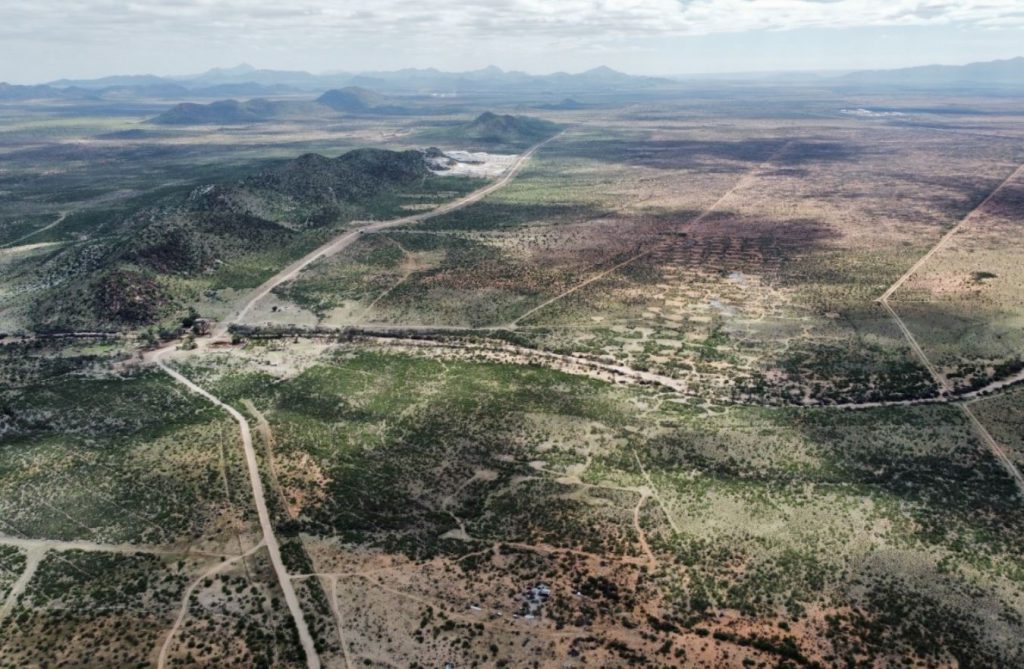Osino Resources drills 1.5 g/t gold over 157 metres at Ondundu, Namibia

Osino Resources Corp. [OSI-TSXV; OSIIF-OTCQX; RSR1-FSE] provided an update on the recently completed infill and orientation drill program at the Ondundu gold project, Namibia.
Highlights: A total of 3,148 metres of reverse circulation (RC) drilling was completed in 15 holes since the publication of the Ondundu maiden mineral resource estimate (MRE).
Assays received from RC step-out and infill holes at Ondundu include ONRC23-019 that returned 157 metres at 1.50 g/t (55 to 212 m), including 54 metres at 1.76 g/t gold, five metres at 7.36 g/t gold and three metres at 22.21 g/t gold. ONRC23-015 returned 51 metres at 1.92 g/t (153 to 204 m), including 42 metres at 2.24 g/t.
ONRC23-013 returned 10 metres at 2.65 g/t (31 to 41 m) and 88 metres at 0.98 g/t (53 to 141 m). ONRC23-014 returned 70 metres at 1.02 g/t (zero to 70 m) including 17 metres at 2.30 g/t and 41 metres at 0.85 g/t (99 to 140 m).
ONRC23-022 returned seven metres at 2.25 g/t (41 to 48 m) and 69 metres at 1.36 g/t (129 to 198 m), including 12 metres at 2.67 g/t gold and six metres at 4.57 g/t gold (211 to 217 m).
Metallurgical testwork samples were recently tested on sensor-based optical sorting machines which returned excellent separation of the gold-bearing quartz veins against the homogenous sediment, indicating very good preconcentration potential.
Previous metallurgical testwork indicated gold recovery in the range of 76 to 79 per cent from gravity only (after milling to 80 per cent passing 75 micron), at less than 5 per cent mass pull of the solid feed to the circuit.
In addition to infill and stepout drilling, the objective of the program was to evaluate alternative assay techniques more suitable to the very pronounced gold nugget effect at Ondundu.
Results from the orientation program will be used to plan a larger infill and resource expansion drill program across the Ondundu deposit.
Osino remains focused on the financing and construction activities for the Twin Hills gold project, while progressing its other exploration projects including Ondundu.
The Ondundu drill program was designed to upgrade the mineral resource around the Razorback Main zone while the orientation program will provide guidance on the optimum drilling, sampling and assay methodologies for future work in the nuggety coarse gold mineralization at Ondundu.
Dave Underwood, Osino’s vice-president of exploration commented: “The short drill program we recently completed at Ondundu has produced some exceptional intercepts including 157 metres at 1.50 g/t gold in hole ONRC23-019 and 109 metres at 2.30 g/t gold as previously reported in hole ONRC23-017. These results indicate potential to increase the size and grade of the main ore zones with further detailed infill and stepout drilling. In addition, the two holes drilled in a westerly orientation to check for mineralization perpendicular to the main ore shoots, intersected unexpected mineralization to the east of the current resource and indicate potential to define a new zone of mineralization in an area never previously drilled.”
Ondundu’s drill program was designed to upgrade the mineral resource around the Razorback main zone and to conduct an orientation program to optimize drilling, sampling and assay techniques with a specific emphasis on capturing the potential upside due to the very pronounced nugget effect at Ondundu.
A total of 3,148 m was completed in 15 reverse circulation (RC) holes at Razorback main zone, aimed at stepout drilling and to infill previous drilling carried out by B2Gold in 2016. These holes were drilled towards a 70-degree azimuth with 60-degree inclinations, resulting in a net combined interhole spacing of about 16 metres.
There is significant scope for the Ondundu MRE to be improved in the next iteration, through better definition and modelling. Additionally, stepout drilling is required to further extend the mineralized zones to the west and east of the current model.
Osino is focused on the fast-tracked development of the wholly owned, Twin Hills gold project in central Namibia. Since its grassroots discovery by Osino in August 2019, the company has completed more than 225,000 metres of drilling and has completed a suite of specialist technical studies culminating in the recently published Twin Hills definitive feasibility study (DFS). The DFS describes a technically simple and economically robust open-pit gold operation with a 2.15 million ounce gold reserve, 13-year mine life and average annual gold production of over 169,000 oz per annum.
Osino has a commanding ground position of approximately 8,000 km2 located within Namibia’s prospective Damara sedimentary mineral belt, mostly in proximity to and along strike of the producing Navachab and Otjikoto gold mines.
The company’s core projects are favourably located north and northwest of Namibia’s capital city Windhoek.
